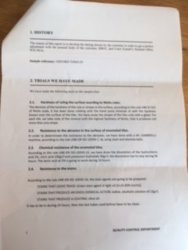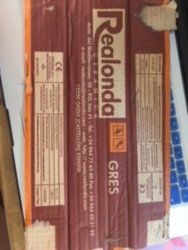T
Tile Shop
Sorry for the delay, been a busy morning.
I'm about to email our contact with the images. However, having looked at the pictures again, I notice the white part of the octagons have darkened from the original look.
The test you did, if the tile was naturally faulty or the glaze was fading/bleeding, either the acid in the vinegar or the bleach, from past experience, would have had some kind of affect.
Now please please please don't take this the wrong way, I'm not saying you are dirty people and I also have a dog that likes to get mucky in the garden and bring it in and staying on top of the cleaning can be a nightmare. But my only other thought is if there is dirt showing, obviously more visible white tiles, this would also pose as a risk for surface abrasion. You may have clean indoor footwear (or no footwear) but this dirt will contain grit and it can still be dragged across the surface by any foot traffic creating like a fine, almost sand-paper like effect. This will abrade the glaze over time and the more surface dirt there is, the quicker it will happen.
The surface of glazed tiles is hard wearing, but not indestructible. So this could happen on any tile to varying extents.
However, I would be questioning the wearing grade, as grade 4 (according to the only reference to this tile I could find on a foreign website) "should" be able to withstand this type of abrasion/scratching dirt if that is indeed the cause of the problem and especially if this dirt is minimal:
"BS EN 14411:2012 EN 14411:2012 (E) - Annex M (informative)
- Class 3:
Floor coverings in areas that, with normal footwear, are walked on more often with small amounts of scratching dirt (e.g. residential kitchens, halls, corridors, balconies, loggias and terraces). This does not apply to abnormal footwear (i.e. hobnailed boots).
Class 4:
Floor coverings that are walked on by regular traffic with some scratching dirt so that the conditions are more severe than Class 3 (e.g. entrances, commercial kitchens, hotel, exhibition and sale rooms)."
Wear isn't visible on the white parts of the tile, only the black but based on how yours have worn, the same test (ISO10545/7) conducted on the black parts of the tile, I would have thought have shown the abrasion significantly quicker, thus reducing the wear grade possibly to as little as grade 2 and therefore unsuitable for kitchen use.
I will send your images to the factory and ask for a datasheet to confirm the abrasion resistance and we can at least look to see if the tile has been mis-sold for your situation.
I'm about to email our contact with the images. However, having looked at the pictures again, I notice the white part of the octagons have darkened from the original look.
The test you did, if the tile was naturally faulty or the glaze was fading/bleeding, either the acid in the vinegar or the bleach, from past experience, would have had some kind of affect.
Now please please please don't take this the wrong way, I'm not saying you are dirty people and I also have a dog that likes to get mucky in the garden and bring it in and staying on top of the cleaning can be a nightmare. But my only other thought is if there is dirt showing, obviously more visible white tiles, this would also pose as a risk for surface abrasion. You may have clean indoor footwear (or no footwear) but this dirt will contain grit and it can still be dragged across the surface by any foot traffic creating like a fine, almost sand-paper like effect. This will abrade the glaze over time and the more surface dirt there is, the quicker it will happen.
The surface of glazed tiles is hard wearing, but not indestructible. So this could happen on any tile to varying extents.
However, I would be questioning the wearing grade, as grade 4 (according to the only reference to this tile I could find on a foreign website) "should" be able to withstand this type of abrasion/scratching dirt if that is indeed the cause of the problem and especially if this dirt is minimal:
"BS EN 14411:2012 EN 14411:2012 (E) - Annex M (informative)
- Class 3:
Floor coverings in areas that, with normal footwear, are walked on more often with small amounts of scratching dirt (e.g. residential kitchens, halls, corridors, balconies, loggias and terraces). This does not apply to abnormal footwear (i.e. hobnailed boots).
Class 4:
Floor coverings that are walked on by regular traffic with some scratching dirt so that the conditions are more severe than Class 3 (e.g. entrances, commercial kitchens, hotel, exhibition and sale rooms)."
Wear isn't visible on the white parts of the tile, only the black but based on how yours have worn, the same test (ISO10545/7) conducted on the black parts of the tile, I would have thought have shown the abrasion significantly quicker, thus reducing the wear grade possibly to as little as grade 2 and therefore unsuitable for kitchen use.
I will send your images to the factory and ask for a datasheet to confirm the abrasion resistance and we can at least look to see if the tile has been mis-sold for your situation.
Last edited by a moderator:




